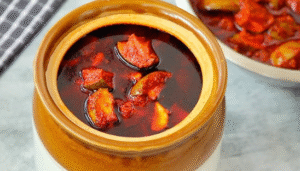Avakaya Pachadi — A timeless Andhra delicacy crafted from handpicked raw mangoes, freshly ground mustard, aromatic spices, and pure gingelly oil. Known for its intense flavour and rich heritage, this traditional pickle promises a taste of authentic South India in every bite.

Avakaya Pachadi is a legendary South Indian pickle, deeply cherished in the states of Andhra Pradesh and Telangana. Crafted from fresh, raw mangoes cut into hearty chunks, it is generously seasoned with a robust blend of mustard seeds, red chili powder, fenugreek seeds, turmeric, salt, and plenty of gingelly (sesame) oil. The name “Avakaya” itself comes from “Ava” meaning mustard and “Kaya” meaning raw mango.
Famed for its fiery spice, sharp tang, and rich, earthy notes, Avakaya only grows more flavorful as it matures. Over time, the mango pieces soften and soak in the bold spices, developing a depth of flavor that is both intense and comforting. More than just a pickle, Avakaya is a treasured symbol of Telugu culinary heritage, traditionally prepared in summer when mangoes are abundant, and enjoyed throughout the year.
Typically paired with steaming hot rice, a spoonful of ghee, and sometimes a simple dal or cooling curd, Avakaya brings a warm, nostalgic taste to every meal. Its vibrant spice and unforgettable aroma make it an essential staple in every Andhra household.
PROCESS OF MAKING AVAKAYA PACHADI
Ingredients:
-
Small purple brinjals (eggplants) – about 8–10
-
Oil – 4–5 tablespoons
-
Mustard seeds – ½ teaspoon
-
Cumin seeds – ½ teaspoon
-
Curry leaves – a few
-
Turmeric powder – ½ teaspoon
-
Salt – to taste
-
Coriander leaves – for garnish
For the stuffing masala:
-
Peanuts – 2 tablespoons
-
Sesame seeds – 2 tablespoons
-
Dry coconut (copra) – 2 tablespoons (or fresh coconut)
-
Coriander seeds – 1 tablespoon
-
Cumin seeds – 1 teaspoon
-
Dried red chilies – 4–5 (adjust to spice level)
-
Tamarind – small lemon-sized ball
-
Jaggery – 1 teaspoon (optional)
-
Garlic cloves – 4–5
-
Onion – 1 small (optional, for extra flavor)
-
Red chili powder – 1 teaspoon
-
Garam masala – ½ teaspoon
Preparation Process:
-
Prep the Brinjals:
-
Wash and dry the brinjals.
-
Make two cuts in a cross (like a “+”) from the bottom, keeping the stem intact.
-
Soak them in salt water to prevent browning.
-
Make the Stuffing Masala:
-
Dry roast peanuts until golden. Set aside.
-
Dry roast sesame seeds until they start popping.
-
Dry roast coriander seeds, cumin, and red chilies.
-
Roast coconut slightly (if using dry coconut).
-
Cool everything and grind to a coarse powder first.
-
Then add tamarind, jaggery, garlic, onion, chili powder, garam masala, and salt. Blend into a thick paste (add a few drops of water if needed).
-
Stuff the Brinjals:
-
Cook the Curry:
-
Heat oil in a wide pan.
-
Add mustard seeds and cumin seeds; let them splutter.
-
Add curry leaves.
-
Place the stuffed brinjals carefully into the pan.
-
Fry on medium flame for a few minutes, turning gently.
-
Add the leftover masala mixed with ½ cup of water.
-
Cover and cook on low flame until brinjals are tender (about 20–25 minutes), stirring gently in between.
-
Finish:
-
Adjust salt, sprinkle fresh coriander leaves.
-
Drizzle a little more oil or ghee for extra richness if desired.
-
Serve:
Here’s the traditional process for making Avakaya Pachadi:
Ingredients:
-
Raw mangoes (firm and sour) – 4 to 5 medium-sized (about 1 kg)
-
Mustard seeds – 100 grams (about ½ cup)
-
Red chili powder – 100 to 150 grams (adjust to spice preference)
-
Salt – 100 grams (about ⅔ cup)
-
Methi seeds (fenugreek) – 1 tablespoon
-
Turmeric powder – 1 tablespoon
-
Gingelly oil (Indian sesame oil) – 250 ml (about 1 cup)
Preparation Process:
-
Prep the Mangoes:
-
Choose fresh, firm, sour mangoes with thick skin.
-
Wash and dry the mangoes completely (no moisture at all).
-
Cut into small cubes along with the inner seed layer (shell).
-
Spread on a clean cloth and air-dry for 1–2 hours to remove any surface moisture.
-
Prepare the Mustard-Methi Powder:
-
Dry roast mustard seeds lightly (optional) and grind into a coarse powder.
-
Lightly roast methi seeds until they turn aromatic and grind into a fine powder.
-
Mix the mustard powder, methi powder, salt, turmeric, and red chili powder together.
-
Mix the Mango Pieces:
-
In a wide, clean, and dry bowl, add the mango pieces.
-
Add the prepared spice mix and gently toss/mix so that every piece is well coated.
-
Pour the gingelly oil slowly and mix again so that oil coats all the pieces.
-
Store the Pickle:
-
Transfer the pickle into a clean, dry glass or ceramic jar.
-
Press down lightly and cover the mouth of the jar with a clean cloth.
-
Let it rest at room temperature for 3–4 days.
-
Stir the pickle once daily with a dry spoon.
-
After 3–4 days, the mangoes will soften, and the flavors will deepen.
-
Ready to Eat:
-
Once the pickle matures, you can pour a little more gingelly oil on top for preservation.
-
Serve with hot steamed rice and ghee — heaven! 😋
Some Tips:
-
Always use completely dry hands, spoons, and containers. Moisture spoils pickles.
-
Gingelly oil gives authentic flavor, but you can also use groundnut oil.
-
Adjust chili powder and salt according to the sourness of the mangoes.
-
Good quality A1 red chili powder gives a vibrant color and nice aroma.
”ENJOY YOUR SPICY AVAKAYA THROUGH OUT THE YEAR”

